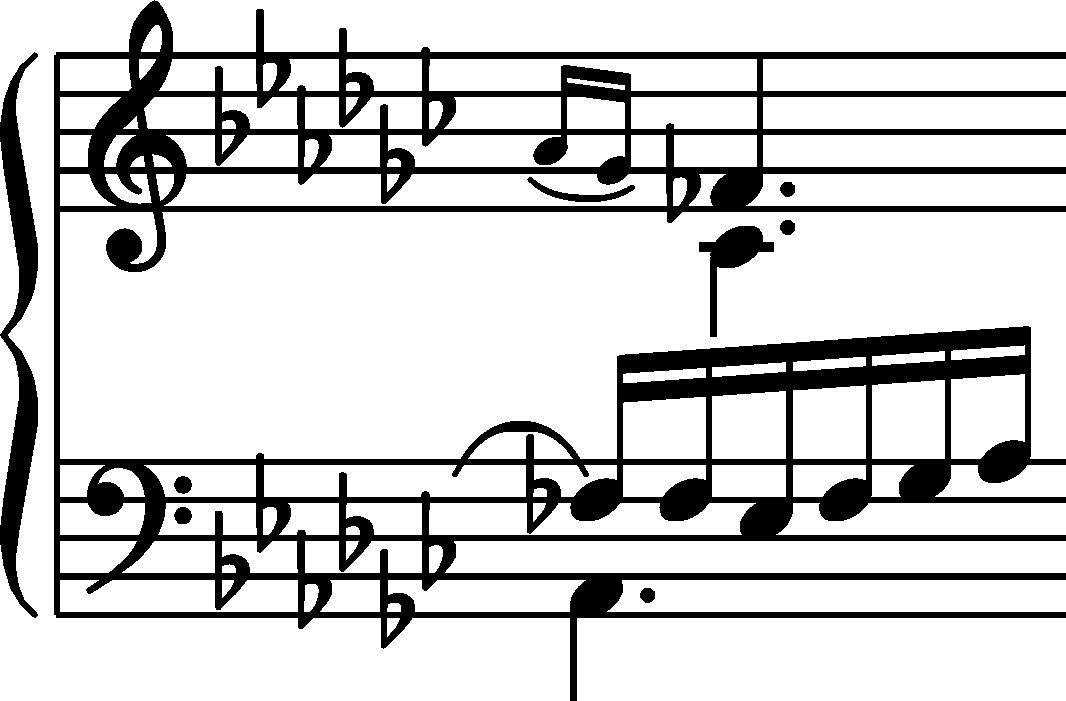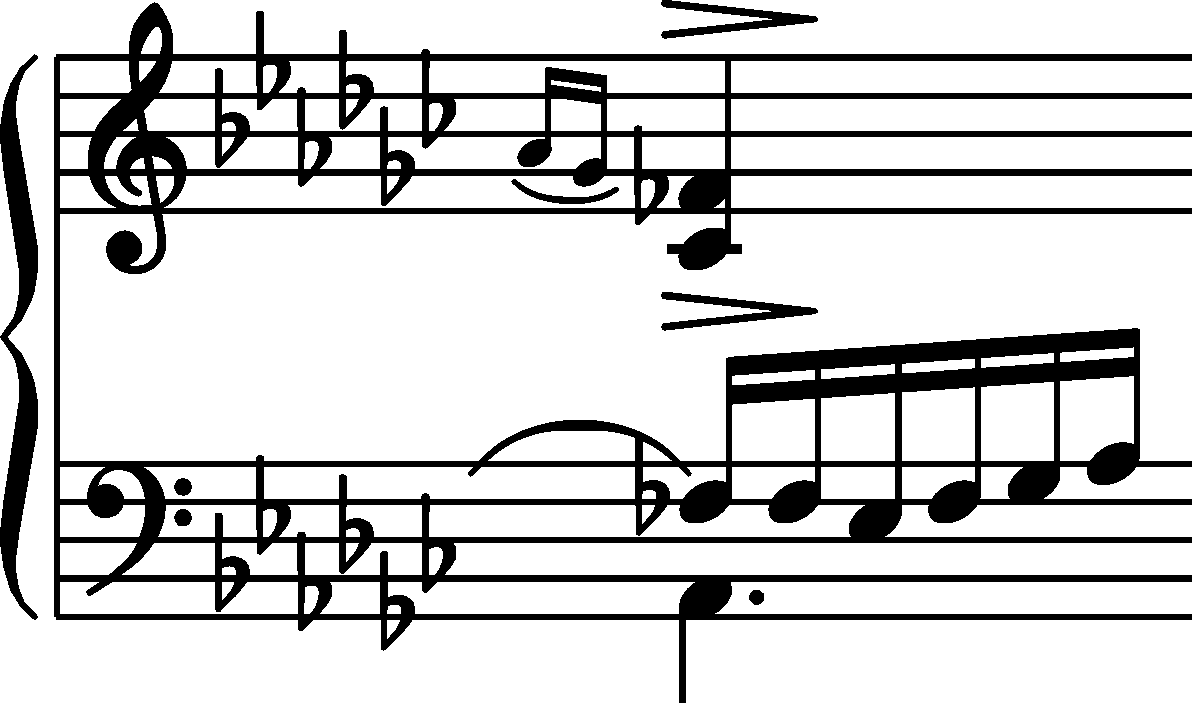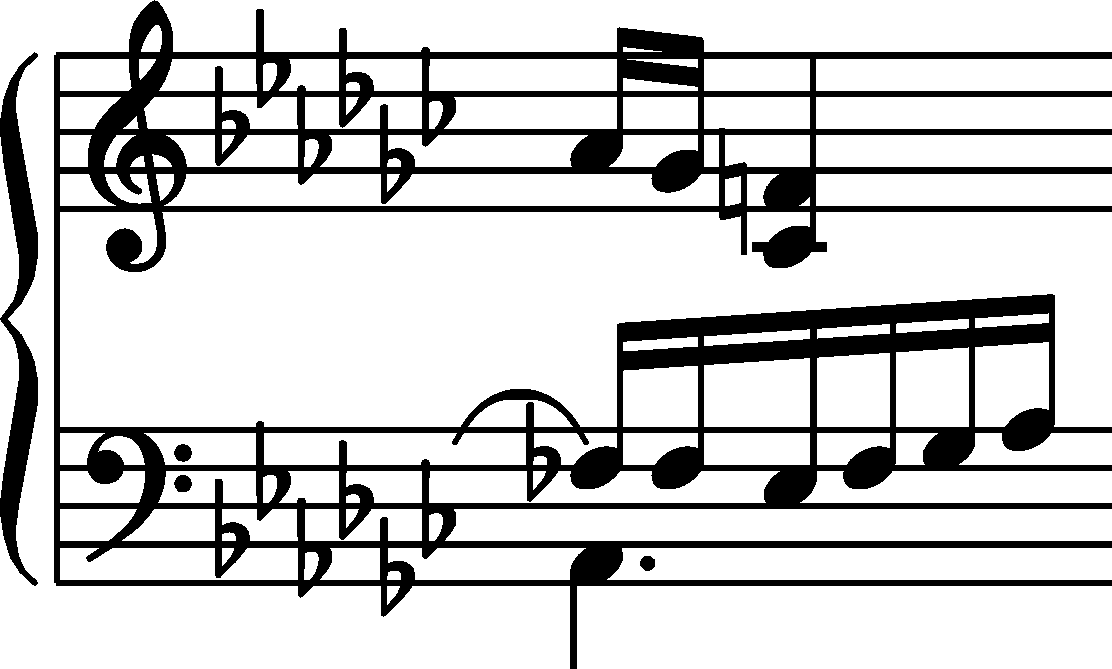




|
Rhythm & c |
|

|
Supplemented interpretation of A |
|

|
||

|
Additional fingering in EE |
|

|
Rhythm & c1 in GE2 |
|

|
||

|
Rhythm & c |
Determining the final intention of Chopin concerning the notation of the beginning of this bar encounters obstacles, while revealing a long list of changes, errors, corrections and revisions. Below we reproduce the part of the transformations' story in which Chopin took part.
-
The first version of A (deleted):
 . Includes only the part of the R.H. written enharmonically in E major. The attention is drawn by the rhythm, including the rhythmic value of the e1 crotchet, going beyond the 1st half of the bar. Lack of possibility to write it with the help of one note, without tie, could have inspired Chopin to reach for the notation using grace notes, which was rhythmically equal, yet more elegant from the graphic point of view.
. Includes only the part of the R.H. written enharmonically in E major. The attention is drawn by the rhythm, including the rhythmic value of the e1 crotchet, going beyond the 1st half of the bar. Lack of possibility to write it with the help of one note, without tie, could have inspired Chopin to reach for the notation using grace notes, which was rhythmically equal, yet more elegant from the graphic point of view. -
The second version of A (deleted):
 . It includes the 1st half of the bar in the flat key. It is worth emphasising that the use of grace notes instead of demisemiquavers generally does not influence the performance, as in such context grace notes are meant to be performed on a strong beat of the bar, together with the notes from the remaining voices, i.e. A
. It includes the 1st half of the bar in the flat key. It is worth emphasising that the use of grace notes instead of demisemiquavers generally does not influence the performance, as in such context grace notes are meant to be performed on a strong beat of the bar, together with the notes from the remaining voices, i.e. A in the bass and c
in the bass and c 1 in the bottom voice in the R.H.
1 in the bottom voice in the R.H. -
The non-deleted version of A differs from the previous one in two elements – the rhythmic value of the c
 1-f
1-f 1 fourth and the manner of vertical alignment of the parts of both hands:
1 fourth and the manner of vertical alignment of the parts of both hands:  . The 2nd element is of key importance for interpreting the composer's intention, as it was probably the reason for discarding the 2nd version and rewriting it. Chopin could have been afraid that the engraver of FE, mislead by the alignment of the L.H. under the right, which is not in line with the rules, would have considered the small notes to be common semiquavers. Unluckily, the oversight of the dots extending the crotchet mislead the engraver anyway, despite the correct alignment of the parts of both hands. It is worth paying attention to two accents – the excess will turn out illusive if we take into consideration the fact that the lower one concerns c
. The 2nd element is of key importance for interpreting the composer's intention, as it was probably the reason for discarding the 2nd version and rewriting it. Chopin could have been afraid that the engraver of FE, mislead by the alignment of the L.H. under the right, which is not in line with the rules, would have considered the small notes to be common semiquavers. Unluckily, the oversight of the dots extending the crotchet mislead the engraver anyway, despite the correct alignment of the parts of both hands. It is worth paying attention to two accents – the excess will turn out illusive if we take into consideration the fact that the lower one concerns c 1, struck at the beginning of the bar, while the upper one – f
1, struck at the beginning of the bar, while the upper one – f 1, performed at least one semiquaver later.
1, performed at least one semiquaver later. -
The original version of FE (possible to be interpreted on the basis of the traces of corrections):
 . Apart from an erroneous interpretation of grace notes as common semiquavers (which is easily understandable in relation to the error of A), another common mistake was committed – a
. Apart from an erroneous interpretation of grace notes as common semiquavers (which is easily understandable in relation to the error of A), another common mistake was committed – a  instead of a
instead of a  was put before f
was put before f 1.
1. -
The final version of FE, in which Chopin corrected the erroneous accidental and moved c
 1 to the correct place.
1 to the correct place.
In GE and EE the rhythm did not undergo any additional changes, however, the revisers of both editions performed additions of accidentals. In EE2 (→EE3) and GE5 only cautionary accidentals were added (justified after sharps in the previous bar), while the arbitrarily added  in GE2 changed the harmonic content, which was only partially corrected in GE3 (→GE4).
in GE2 changed the harmonic content, which was only partially corrected in GE3 (→GE4).
Two versions aspire to be Chopin's final intention:
- The version of A, rhythmically interpreted and corrected on the basis of the aforementioned analysis of the deleted versions;
- The version of FE corrected by Chopin (→GE1, →EE2→EE3).
In the main text we choose the first one, as the full compliance of the correction of FE with Chopin's intention is not certain. It is the rhythm of the first two notes that is particularly dubious, as the semiquavers, being probably a result of the interpretation of the erroneous notation of A, performed ad hoc by the engraver of FE, form parallel f -g
-g 1 and e
1 and e -f
-f 1 ninths with the tenor voice.
1 ninths with the tenor voice.
The fingering added in EE is discussed separately.
Compare the passage in the sources »
category imprint: Interpretations within context; Differences between sources; Editorial revisions; Corrections & alterations
issues: Chopin's hesitations, GE revisions, Authentic corrections of FE
notation: Rhythm

